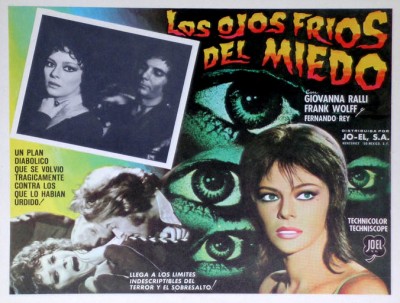| Reviews & Columns |
|
Reviews DVD TV on DVD Blu-ray 4K UHD International DVDs In Theaters Reviews by Studio Video Games Features Collector Series DVDs Easter Egg Database Interviews DVD Talk Radio Feature Articles Columns Anime Talk DVD Savant Horror DVDs The M.O.D. Squad Art House HD Talk Silent DVD
|
DVD Talk Forum |
|
|
| Resources |
|
DVD Price Search Customer Service #'s RCE Info Links |
|
Columns
|
|
|
Cold Eyes of Fear
Cold Eyes of Fear (Gli occhi freddi della paura, or "Cold Eyes of Fear," 1971), also known as Desperate Moments, is a decidedly minor giallo entry, despite the involvement of director Enzo G. Castellari (Inglorious Bastards) and iconic composer Ennio Morricone. Talky, stagy, and ultimately rather dull, it's more or less The Not-So-Desperate Hours.
A Redemption Films release through Kino Lorber, Cold Eyes of Fear has in its favor a good high-def video transfer with especially vivid color, though the English-only dialogue seems mixed way too low for my ears, with Morricone's score completely overpowering at times.
Despite what it says on this Mexican lobby card, the film is 1.85:1 widescreen, not Techniscope
Cold Eyes of Fear is an Italian (Cinemar)-Spanish (Atlántida) co-production but set entirely in London. Nevertheless, all of the interiors were filmed at Rome's Cinecittà studios while most of the exteriors were "stolen" on London streets, presumably without permits or any sort of crowd control. The purpose of the London setting isn't clear, nor does the mismatching exteriors and interiors (with their Continental furniture and other knickknacks) and dubbed-in Cockney accents convince.
However, the taken-on-the-sly London street footage is the best thing about the movie, offering viewers a rare view of 1970 Swinging London. The dusk- and night-for-night cinematography captures the Piccadilly (?) area with various cinemas glimpsed (one showing something called Cool It Carol and another running Billy Wilder's The Private Life of Sherlock Holmes) and a terrific strip- and nightclub where Peter (Gianni Garko), the nephew of a prominent judge, picks up a hooker, Italian Anna (Giovanna Ralli). He takes her home to his uncle's mansion, hoping to impress her with his wealth, but an intruder (Cockney-speaking Julián Mateos) in search of a hidden safe interrupts their lovemaking.
The uncle, Judge Flower (Fernando Rey, likewise unconvincingly dubbed with an English accent), sends a policeman (Frank Wolff) to the mansion to drop off some documents, but when Peter tries to whisper a plea for help at the doorway, the officer, later identified as Arthur Welt, punches Peter's lights out. That's because he's actually an ex-con who believes the judge unjustly sent him to the slammer to cover his own fortune-making corruption. (This may be why the setting was moved to London rather than the more obvious Rome.)
The still-active Ralli, who's enjoyed a film career stretching back to childhood and the early 1940s, is gorgeous here, while expat American Frank Wolff (The Wasp Woman, Once Upon a Time in the West), who began with Roger Corman in the fifties before settling in Europe after 1960, is excellent in the key role of revenge-minded Arthur Welt. This was, sadly, one of the actor's final roles; he committed suicide later in 1971.
Morricone's trippy, jazz-on-acid score is another draw through it's not one of my favorite of his film scores. Castellari's direction is rather lazy, and the film lacks the vibrant style of the best giallo. There's a lot of talk, threats of violence, flashes of nudity and few surprises. Watching it I felt rather like Fernando Rey's fluffy pussycat, who spends almost the entire film dead asleep on the judge's desk.
Video & Audio
〠Presented in 1080p, 1.85:1 widescreen and sourced from the original camera negative, Cold Eyes of Fear has its share of scratches and signs of wear but the image is sharp and the color is great. The opening title card is video-supered in, with other titles in English. The mono audio, English only, is problematic. The dialogue track seemed awfully low and I found myself straining to catch a lot of it, while the music and effects tracks blares away at other times. Oddly, the endless crackling of the soundtrack was most prominent on my rear speakers, sounding like rain just outside my window. The IMDb reports a longer Italian cut but this version, running 91 minutes, seems complete to me.
Extra Features
The only extra is an international trailer, also in high-def, under the Desperate Moments title. Trailers for a few other Redemption titles are also tossed in.
Parting Thoughts
Very minor as giallo but a fine high-def presentation of a so-so film, Cold Eyes of Fear is worth a single viewing but not much beyond that. For fans it's mildly Recommended though others may want to rent it first.
Stuart Galbraith IV is a Kyoto-based film historian whose work includes film history books, DVD and Blu-ray audio commentaries and special features. Visit Stuart's Cine Blogarama here.
|
| Popular Reviews |
| Sponsored Links |
|
|
| Sponsored Links |
|
|
| Release List | Reviews | Shop | Newsletter | Forum | DVD Giveaways | Blu-Ray | Advertise |
|
Copyright 2024 DVDTalk.com All Rights Reserved. Legal Info, Privacy Policy, Terms of Use,
Manage Preferences,
Your Privacy Choices | |||||||















